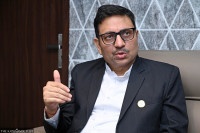Culture & Lifestyle
Can computers replace classrooms?
As a result of the nation-wide lockdown, colleges have rolled out online classes. But their effectiveness is questionable in a country where traditional pedagogy approaches are still highly practised..jpg&w=900&height=601)
Ankit Khadgi & Aditi Aryal
Pragya Joshi didn't think much when her teachers told her classes would now be held virtually. As even during regular classes, professors would use slides and students would mostly read related articles online, the decision to go digital to continue teaching during the lockdown didn’t make her uncomfortable.
But the 24-year-old master’s student at Kathmandu University's School of Arts didn't expect the switch online to be so drastic and how it severely limited interactivity.
“In class, the teachers could demonstrate and make us understand the subject matter and ask questions. But now the classes aren’t as interactive because of the technology barrier, because we can’t interact the way we could in physical classes," said Joshi, who has been signing up for two-hour classes for a week.
As the Covid-19 pandemic continues to unfold, universities and schools around the world have opted for virtual classes in an effort to continue with their curricula while maintaining social distancing. Nepali colleges and universities are making the switch too. However, the effectiveness of virtual classes in Nepal remains questionable, given that traditional pedagogical practises are still a major part of Nepali academic institutions.
According to Chandiraj Dahal, assistant professor of media studies at the Kathmandu University School of Arts, face-to-face interactions are always more effective than mediated communication, such as using internet technologies.
“As a teacher, mediated communication is not my first choice, but given the situation, I would definitely agree that virtual classrooms have much to offer and have diminished physical barriers,” said Dahal.
After the government declared a lockdown on March 24, the School of Arts introduced an online learning management system, providing a platform for students and professors to share learning materials and even assign and evaluate assignments.
“We have been using platforms like Google Meet, as it’s more apt for conducting classes of 25-30 students at a time,” said Dahal. “The application allows us to share our screen and make slide presentations as well but most importantly, it allows teachers or presenters to host and control the microphones of other members. Such features make the virtual room as effective as a real classroom, and it seems to be working as we are attracting hundred percent attendance.”
A number of other institutions of higher learning have also introduced virtual classes, and are reporting better attendance rates.
“Initially, we were apprehensive regarding the turnout but the attendance for every session is almost 90 percent,” said Sandesh Karmacharya, manager of MBA at ACE Institute of Management, which has been operating online MBA classes for about three weeks now.
However, online classes don't always work well, especially when internet connectivity isn't stable, leading students to miss out on lectures and discussions.
“Although we try to attend all classes, many of my classmates are unable to access lectures because of internet connectivity problems,” said Sumina Pradhan, an MBA student at Boston International College in Chitwan.
Pratibha Pant, a second-year student at National College in Kathmandu, shared similar sentiments.
“Some classes for students in the first and fourth years are being held online via Google Meet. However, this option has been contested by many students in my year who have returned to their villages due to the lockdown and stable internet is unavailable,” she said.
As faster internet connections remain a luxury, students from underprivileged families do not have equal access, and when they do, they may not have an easy experience online. According to research from Columbia University, students from marginalised families struggle more in online classes.
Another major challenge is the possibility of distraction during virtual classes. As students may not have strict disciplinary codes of conduct, like they have in a traditional setting, chances are there that they might use their phones or get easily distracted. Research suggests that students in online courses are more likely to be distracted and have a propensity to use social media more than those attending physical classes.
Dahal acknowledges online education is not for everyone, due to issues of connectivity, bandwidth and power supply. But he believes that in this situation, it is the best option for students to continue their education. “We aren’t trying to burden them, he said. "The intention is to spread hope that things will be alright soon. I believe continuing with studies is one-way students can realise that crises are inevitable in our society."
And some students agree.
“My days aren’t being wasted. I have been spending my time reading and writing my assignments. The classes are fruitful and they provide a distraction from the overwhelming situation,” said Joshi.
Schools too are using online tools to keep students engaged. Ullens School in Kathmandu has been conducting online classes for its IB students, while Modern Indian School is using social media to stay connected with its students.
“Through WhatsApp groups, teachers have been assigning students one assignment per subject daily,” said Geeta Dhungel, who teaches Nepali at Modern Indian School. “Besides helping us stay connected to students, online apps have also been helpful in sharing examination results and other important announcements and decisions with parents,” she added.




 7.12°C Kathmandu
7.12°C Kathmandu
















